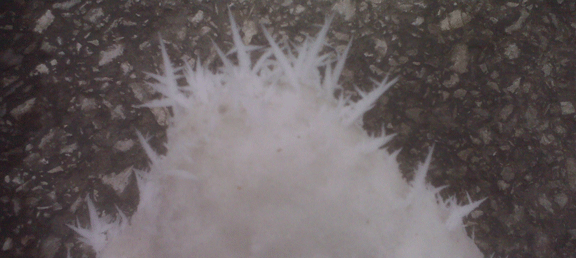Science Collaborative - Crystals
|
Science starts with a question. A question always starts with an observation that catches the eye. |
 |
This cell phone picture was taken in the parking lot at Oakwood Mall in Enid, Oklahoma. Like many places, it can generate many questions. Questions generated through patient observation.
- Take up the challenge. Among your peers take turns making as many observations as possible (one at time) making sure to list each. Challenge others to be the last to make the last observation. Maybe before you start you want to "define" what qualifies as an observation.
- Once all observations have been made, try to make as many questions as possible based on the list of observations. Again maybe, as a group, you want to define what makes a good question.
- Consider any visual (e.g., photograph, diagram, video, graph) that is uploaded to this Science Collaborative Virtual Locker could be considered a wealth of possibilities for practice making observations and questions based on them.
Standards
-
PASS: Science > Physics > Science Processes and Inquiry > PS.1 > O.1
Identify qualitative and quantitative changes given conditions (e.g., temperature, mass, volume, time, position, length) before, during, and after an event.
Content Skills Learning Targets Big Ideas Essential Questions Changes1 - Identify (changes in systems)
1 - identify changes in rate/time before, during, after an event.
1 - identify changes in position before, during, after an event.
Through qualitative and quantitative observations of a system reveals new information.
For a given event involving a system, what conditions should be observed?
How do conditions change before, during, and after an event involving a system?
-
PASS: Science > Physics > Science Processes and Inquiry > PS.1 > O.2
Use appropriate tools with accuracy and precision (e.g., metric ruler, graduated cylinder, thermometer, balance, spring scale, stopwatch, probeware, graphing calculators, digital cameras, computer simulations) when measuring objects and/or events.
-
PASS: Science > Physics > Science Processes and Inquiry > PS.1 > O.3
Use appropriate International System of Units (SI) (i.e., grams, meters, liters, degrees Celsius, and seconds) and SI prefixes (i.e., micro-, milli-, centi-, and kilo-) when measuring objects and/or events.
-
Common Core ELA Standards for Science/Technical: 11-12 > IKI > S.7
Integrate and evaluate multiple sources of information presented in diverse formats and media (e.g., quantitative data, video, multimedia) in order to address a question or solve a problem.Content Skills Learning Targets Big Ideas Essential Questions Information Sources (e.g.)4 - Integrate (multiple sources of information)
4 - I can integrate multiple sources of information in diverse formats to address a question.
A. Information presented in diverse formats and media requires one to be able to integrate and evaluate sources in order to address a question or solve a problem.
A.1 What strategies may be used to integrate diverse sources of information? How might these strategies vary depending on addressing a question or solving a problem?